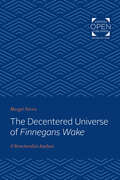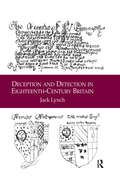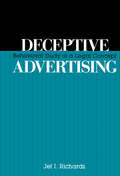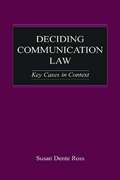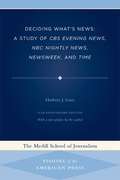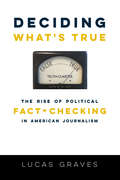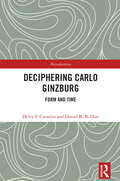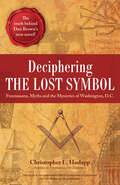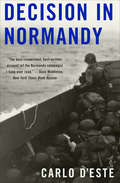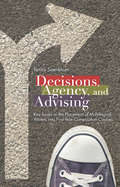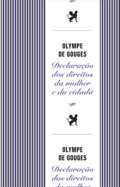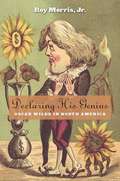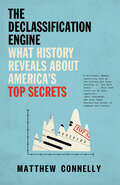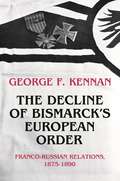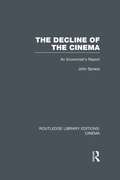- Table View
- List View
The Decentered Universe of Finnegans Wake: A Structuralist Analysis
by Margot NorrisOriginally published in 1977. The pioneer critics of Finnegans Wake hailed the work as a radical critique of language and civilization. Resuming their position, Margot Norris explains the book's most intractable uncertainties not as puzzles to be solved by a clever reader but as manifestations of a "chaosmos," a Freudian dream world of sexual transgression and social dissolution, of inauthentic being and empty words. Conventional moralities and restraints are under siege in this chaosmos, where precisely those desires and forbidden wishes that are barred in waking thought strive to make themselves felt. Norris demonstrates convincingly that the protean characters of Finnegans Wake are the creatures of a dreaming mind. The teleology of their universe is freedom, and in the enduring struggle between the individual's anarchic psyche and the laws that make civilization possible, it is only in dream that the psyche is triumphant. It is as dream rather than as novel that Norris reads Finnegans Wake. The lexical deviance and semantic density of the book, Norris argues, are not due to Joyce's malice, mischief, or megalomania but are essential and intrinsic to his concern to portray man's inner state of being. Because meanings are dislocated—hidden in unexpected places, multiplied and split, given over to ambiguity, plurality, and uncertainty—the Wake, Norris claims, represents a decentered universe. Its formal elements of plot, character, discourse, and language are not anchored to any single point of reference; they do not refer back to center. Only by abandoning conventional frames of reference can readers allow the work to disclose its own meanings, which are lodged in the differences and similarities of its multitudinous elements.Eschewing the close explication of much Wake criticism, the author provides a conceptual framework for the work's large structures with the help of theories and methods borrowed from Freud, Heidegger, Lacan, Levi-Strauss, and Derrida. Looking at the work without novelistic expectations of the illusion of some "key" to unlock the mystery, Norris explores Joyce's rationale for committing his last human panorama—a bit sadder than Ulysses in its concern with aging, killing, and dying—to a form and language belonging to the deconstructive forces of the twentieth century.
Deception and Detection in Eighteenth-Century Britain
by Jack LynchIn the first extended treatment of the debates surrounding public deception in eighteenth-century Britain, Jack Lynch contends that forgery, fakery, and fraud make explicit the usually unspoken grounds on which Britons made sense of their world. Confrontations with inauthenticity, in other words, bring tacitly understood conceptions of reality to the surface. Drawing on a wide range of contemporary print and manuscript sources”not only books and pamphlets, but ballads, comic prints, legal proceedings, letters, and diaries”Lynch focuses on the debates they provoked, rather than the forgers themselves. He offers a comprehensive treatment of the criticism surrounding fraud in most of the noteworthy controversies of the long eighteenth century. To this end, his study is structured around topics related to the arguments over deception in Britain, whether they concerned George Psalmanazar's Formosan hoax at the beginning of the eighteenth century or William Henry Ireland's Shakespearean imposture at the end. Beginning with the question of what constitutes deception and ending with an illuminating chapter on what was at stake in these debates for eighteenth-century British thinkers, Lynch's accessibly written study takes the reader through the means”whether simple, sophisticated, or tortuously argued”by which partisans on both sides struggled to define which of the apparent contradictions were sufficient to disqualify a claim to authenticity. Fakery, Lynch persuasively argues, transports us to the heart of eighteenth-century notions of the value of evidence, of the mechanisms of perception and memory, of the relationship between art and life, of historicism, and of human motivation.
Deceptive Advertising: Behavioral Study of A Legal Concept (Routledge Communication Series)
by Jef RichardsThis is the first book designed to assist behavioral scientists in the preparation of scholarly or applied research regarding deceptive advertising which will ultimately affect public policy in this area. Because there was an inadequate foundation upon which to build a program of research for this topic, a three-part solution has been devised: 1) a review of how deception is viewed and regulated 2) a theory of how consumers process deceptive information 3) a sensitive and consistent means of measuring deceptiveness. This text provides detailed discussions regarding the intersection of law and behavioral science and its application to deceptive advertising. In so doing, it offers a solid foundation upon which to base expanded behavioral research into how consumers are deceived by advertising claims, and what cognitive processes are involved in that deception.
Deciding Communication Law: Key Cases in Context (Routledge Communication Series)
by Susan Dente RossThis clearly written and well-focused volume combines concise decisions of the primary areas of communication law with the foundational case decisions in those domains. Thus, in one volume, students of communication law, constitutional law, political science, and related fields find both the key rulings that define each area of law and a detailed summary of the legal concepts, doctrines, and policies so vital to understanding the rulings within their legal context. The text forgoes the tendency to provide encyclopedic treatment of all the relevant cases and focuses instead on the two or three cases most vital to an accurate and informed understanding of the current state of each field of communication law. The chapters provide readers with the most salient concepts and the necessary depth to understand the law while permitting most reading time to be directed to the law itself. Full-text rulings allow readers to immerse themselves in the law itself--to develop a feel for its complexity, its flexibility, and its language. Useful as a quick reference to the landmark rulings and the jurisprudence of communication law, this book also serves well as the primary text in related undergraduate courses or as a supplemental text in graduate classes in the field.
Deciding What's News: A Study of CBS Evening News, NBC Nightly News, Newsweek, and Time (Medill Visions of the American Press)
by Herbert Gans<p>For ten years, Herbert J. Gans spent considerable time in four major television and magazine newsrooms, observing and talking to the journalists who choose the national news stories that inform America about itself. Writing during the golden age of journalism, Gans included such headline events as the War on Poverty, the Vietnam War and the protests against it, urban ghetto disorders, the assassinations of Martin Luther King, Jr. and Robert F. Kennedy, and Watergate. He was interested in the values, professional standards, and the external pressures that shaped journalists' judgments. <p>Deciding What's News has become a classic. A new preface outlines the major changes that have taken place in the news media since Gans first wrote the book, but it also suggests that the basics of news judgment and the structures of news organizations have changed little. Gans's book is still the most comprehensive sociological account of some of the country's most prominent national news media. The book received the 1979 Theatre Library Association Award and the 1980 Book Award of the National Association of Educational Broadcasters. This is the first work to be published under the Medill School of Journalism's "Visions of the American Press" imprint, a new journalism history series featuring both original volumes and reprints of important classics.</p>
Deciding What's True: The Rise of Political Fact-Checking in American Journalism
by Lucas GravesOver the past decade, American outlets such as PolitiFact, FactCheck.org, and the Washington Post's Fact Checker have shaken up the political world by holding public figures accountable for what they say. Cited across social and national news media, these verdicts can rattle a political campaign and send the White House press corps scrambling. Yet fact-checking is a fraught kind of journalism, one that challenges reporters' traditional roles as objective observers and places them at the center of white-hot, real-time debates. As these journalists are the first to admit, in a hyperpartisan world, facts can easily slip into fiction, and decisions about which claims to investigate and how to judge them are frequently denounced as unfair play.Deciding What's True draws on Lucas Graves's unique access to the members of the newsrooms leading this movement. Graves vividly recounts the routines of journalists at three of these hyperconnected, technologically innovative organizations and what informs their approach to a story. Graves also plots a compelling, personality-driven history of the fact-checking movement and its recent evolution from the blogosphere, reflecting on its revolutionary remaking of journalistic ethics and practice. His book demonstrates the ways these rising organizations depend on professional networks and media partnerships yet have also made inroads with the academic and philanthropic worlds. These networks have become a vital source of influence as fact-checking spreads around the world.
Deciding What’s True: The Rise of Political Fact-Checking in American Journalism
by Lucas GravesOver the past decade, American outlets such as PolitiFact, FactCheck.org, and the Washington Post's Fact Checker have shaken up the political world by holding public figures accountable for what they say. Cited across social and national news media, these verdicts can rattle a political campaign and send the White House press corps scrambling. Yet fact-checking is a fraught kind of journalism, one that challenges reporters' traditional roles as objective observers and places them at the center of white-hot, real-time debates. As these journalists are the first to admit, in a hyperpartisan world, facts can easily slip into fiction, and decisions about which claims to investigate and how to judge them are frequently denounced as unfair play. Deciding What's True draws on Lucas Graves's unique access to the members of the newsrooms leading this movement. Graves vividly recounts the routines of journalists at three of these hyperconnected, technologically innovative organizations and what informs their approach to a story. Graves also plots a compelling, personality-driven history of the fact-checking movement and its recent evolution from the blogosphere, reflecting on its revolutionary remaking of journalistic ethics and practice. His book demonstrates the ways these rising organizations depend on professional networks and media partnerships yet have also made inroads with the academic and philanthropic worlds. These networks have become a vital source of influence as fact-checking spreads around the world.
Deciphering Carlo Ginzburg: Form and Time (ISSN)
by Deivy F. Carneiro Daniel R. DiasThis book offers an original reading of Carlo Ginzburg’s work, tracing his trajectory in the context of Italian micro-history, his debates on the objectivity of historical knowledge, and the connection of his work to the expanded perspectives constructed in recent decades by global history.Ginzburg's theories have achieved notoriety not only in the field of history but also among the wider public. This volume uses Ginzburg’s own aesthetic and intellectual practices in its analysis, and it deciphers the elements that drove and influenced the making of his work. By highlighting the procedures that Ginzburg has constructed to respond to problems of cultural history, the book also pays close attention to Erich Auerbach and Aby Warburg, whose influences played a crucial role in reformulating Ginzburg’s conception of micro-history. From there, the volume demonstrates the radicality of Ginzburg's micro-history through the discussion of some of his most recent contributions to international historiographical debates.Thought-provoking and thoroughly researched, Deciphering Carlo Ginzburg is an innovative study in Ginzburg’s methods and theories.
Deciphering the Lost Symbol: Freemasons, Myths and the Mysteries of Washington, D.C.
by Christopher I HodappDiscover the secretive brotherhood behind Dan Brown’s The Lost Symbol in this unauthorized companion book by the author of Solomon’s Builders.Freemason influence on the founding of Washington, D.C., is evident throughout the city’s buildings, statues and monuments—but it’s written in coded symbols that few people understand. Dan Brown’s thriller sends symbologist detective Robert Langdon through the capital to unravel its Masonic secrets. Now in Deciphering The Lost Symbol, Freemason expert Christopher L. Hodapp compares each clue and plot twist in Brown’s story to the true facts.•Discover the meaning of “The Lost Word”•Decode Masonic and alchemical symbolism•Explore the innermost rooms of Masonic lodges and temples•Visit the restricted area of the U.S. Capitol and other landmarks•Uncover secret patterns in Washington, D.C.’s maps and monuments•Crack the codes buried in The Lost Symbol’s artwork and puzzles“Confident in recommending it to everyone, Mason and non-mason alike. This is the perfect a compliment to The Lost Symbol and I feel it should be on the shelf right next to it on your bookcase.” —David Naughton-Shires, Masonic Art Exchange
Decision in Normandy
by Carlo D'EsteThe strategy and planning behind D-Day: &“The best-researched, best-written account [of the Normandy Campaign] I have ever read.&”—The New York Times Book Review One of the most controversial and dangerous military operations in the history of modern warfare, the battle for Normandy took over two years of planning by each country that made up the Allied forces. The event is mired to this day in myth and misconception, and untangling the web of work that led to D-Day is nearly as daunting as the work that led to the day itself. Drawing from declassified documents, personal interviews, diaries, and more, Carlo D&’Este, a winner of the Pritzker Award, uncovers what really happened in Normandy. From what went right to what went wrong, D&’Este takes readers on a journey from the very first moment Prime Minister Churchill considered an invasion through France to the last battles of World War II. With photos, maps, and first-hand accounts, readers can trace the incredible road to victory and the intricate battles in between. A comprehensive look into the military strategy surrounding the Second World War, Decision in Normandy is an absolute essential for history buffs. &“A fresh perspective on the leadership of Field Marshal Bernard Montgomery and the Allied landings after D-Day.&”—Publishers Weekly &“Again and again he reveals new facets of familiar subjects—in part from his own dual American army and British academic background; in part by querying everyone and everything.&”—Kirkus Reviews
Decisions, Agency, and Advising: Key Issues in the Placement of Multilingual Writers into First-Year Composition Courses
by Tanita SaenkhumDecisions, Agency, and Advising considers the role of students’ own agency in the placement of multilingual writers—including international students and US residents or citizens who are nonnative users of English—in US college composition programs. Grounded in qualitative research and concerned equally with theory and practice, the book explores how multilingual students exercise agency in their placement decisions and how student agency can inform the overall programmatic placement of multilingual students into first-year composition courses. Tanita Saenkhum follows eleven multilingual students who made their decisions about placement into first-year composition courses during one academic year at a large public university. She identifies the need for the process of making placement decisions to be understood more clearly, describes how to use that knowledge to improve placement practices for these students—particularly in advising—and offers hands-on recommendations for writing programs. Decisions, Agency, and Advising is a significant contribution to the field and particularly valuable to writing program administrators, academic advisors, writing teachers, researchers investigating second language writing and writing program administration, composition and second language writing scholars, and graduate students.
Declaração dos Direitos da Mulher e da Cidadã
by Christine Escallier Olympe De Gouges Elisa Seixas Isabel RobalinhoEm cada ano, desde 10 de Dezembro de 1948, o mundo celebra a adopção da Declaração Universal dos Direitos do Homem pela Assembleia-geral das Nações Unidas. Este dia capital convoca e recorda que todos os seres humanos são iguais por direito. Esta publicação acontece no âmbito de uma certa efervescência editorial e política contemporânea, a propósito de Olympe de Gouges. (...) Contudo, não se trata somente de celebrar uma personagem, durante muito tempo ignorada, mas também de considerar o que, no pensamento de Olympe de Gouges, se mantém atual: igualdade das mulheres/igualdade dos sexos, não-violência, justiça social, denúncia da escravatura e do racismo, defesa das minorias...
Declaration
by Tom MaschlerEssays from prominent writers about the state of civilization today. Contributions from writers including, Colin Wilson, John Osborne, John Wain, Kenneth Tynan, Bill Hopkins, Lindsay Anderson, Stuart Holroyd, and Doris Lessing.
Declaring His Genius: Oscar Wilde in North America
by Roy Morris Jr.Arriving at the port of New York in 1882, a 27-year-old Oscar Wilde quipped he had nothing to declare but my genius. But as this sparkling narrative reveals, Wilde was, rarely for him, underselling himself. A chronicle of his sensational eleven-month speaking tour of America, Declaring His Genius offers an indelible portrait of both Oscar Wilde and the Gilded Age. Neither Wilde nor America would ever be the same.
The Declassification Engine: What History Reveals About America's Top Secrets
by Matthew ConnellySHORTLISTED FOR THE CUNDHILL HISTORY PRIZE • Every day, thousands of new secrets are created by the United States government. What is all this secrecy really for? And whom does it benefit?&“A brilliant, deeply unsettling look at the history and inner workings of &‘the dark state'.... At a time when federal agencies are increasingly classifying or destroying documents with historical significance, this book could not be more important.&” —Eric Schlosser, New York Times best-selling author of Command and ControlBefore World War II, transparent government was a proud tradition in the United States. In all but the most serious of circumstances, classification, covert operations, and spying were considered deeply un-American. But after the war, the power to decide what could be kept secret proved too tempting to give up. Since then, we have radically departed from that open tradition, allowing intelligence agencies, black sites, and classified laboratories to grow unchecked. Officials insist that only secrecy can keep us safe, but its true costs have gone unacknowledged for too long. Using the latest techniques in data science, historian Matthew Connelly analyzes a vast trove of state secrets to unearth not only what the government really did not want us to know but also why they didn&’t want us to know it. Culling this research and carefully examining a series of pivotal moments in recent history, from Pearl Harbor to drone warfare, Connelly sheds light on the drivers of state secrecy— especially incompetence and criminality—and how rampant overclassification makes it impossible to protect truly vital information. What results is an astonishing study of power: of the greed it enables, of the negligence it protects, and of what we lose as citizens when our leaders cannot be held to account. A crucial examination of the self-defeating nature of secrecy and the dire state of our nation&’s archives, The Declassification Engine is a powerful reminder of the importance of preserving the past so that we may secure our future.
The Decline and Fall of the Lettered City: Latin America in the Cold War (Convergences: Inventories of the Present #24)
by Jean FrancoThe cultural Cold War in Latin America was waged as a war of values--artistic freedom versus communitarianism, Western values versus national cultures, the autonomy of art versus a commitment to liberation struggles--and at a time when the prestige of literature had never been higher. The projects of the historic avant-garde were revitalized by an anti-capitalist ethos and envisaged as the opposite of the republican state. The Decline and Fall of the Lettered City charts the conflicting universals of this period, the clash between avant-garde and political vanguard. This was also a twilight of literature at the threshold of the great cultural revolution of the seventies and eighties, a revolution to which the Cold War indirectly contributed. In the eighties, civil war and military rule, together with the rapid development of mass culture and communication empires, changed the political and cultural map. A long-awaited work by an eminent Latin Americanist widely read throughout the world, this book will prove indispensable to anyone hoping to understand Latin American literature and society. Jean Franco guides the reader across minefields of cultural debate and histories of highly polarized struggle. Focusing on literary texts by García Marquez, Vargas Llosa, Roa Bastos, and Juan Carlos Onetti, conducting us through this contested history with the authority of an eyewitness, Franco gives us an engaging overview as involving as it is moving.
The Decline of Bismarck's European Order: Franco-Russian Relations 1875-1890
by George Frost KennanIn an attempt to discover some of the underlying origins of World War I, the eminent diplomat and writer George Kennan focuses on a small sector of offstage events to show how they affected the drama at large long before the war even began. In the introduction to his book George Kennan tells us, "I came to see World War I . . . as the great seminal catastrophe of this century--the event which . . . lay at the heart of the failure and decline of this Western civilization." But, he asks, who could help being struck by the contrast between this apocalyptic result and the "delirious euphoria" of the crowds on the streets of Europe at the outbreak of war in 1914! "Were we not," he suggests, "in the face of some monstrous miscalculation--some pervasive failure to read correctly the outward indicators of one's own situation?" It is from this perspective that Mr. Kennan launches a "micro-history" of the Franco-Russian relationship as far back as the 1870s in an effort to determine the motives that led people "to wander so blindly" into the horrors of the First World War.
The Decline of the Cinema: An Economist’s Report (Routledge Library Editions: Cinema)
by John SpraosBetween 1952 and 1962, when this book was originally published, the number of people visiting British cinemas had fallen by nearly two thirds and was little more than half the pre-war total. Nearly 1500 of the 4500 cinemas functioning in 1955 had closed five years later, and the author here predicts a further substantial fall. The causes of this drastic decline are traced to the competition of television but also to the dramatic halving of the number of new American films and to the difficulty of transferring a cinema’s ‘congregation’ when it is closed. This decline has few parallels in recent times and in conjunction with a disproportionate and unexpected increase in the price of seats presents a fascinating study for the economist, which the author fully exploits. But the film industry is of general interest so that the author’s conclusions and his social recommendations will appeal to the general reader as well as those in the industry.
Decodable Reader
by Action Learning Systems Inc. Robin Scarcella Isabel L. Beck Margaret MckeownNIMAC-sourced textbook
